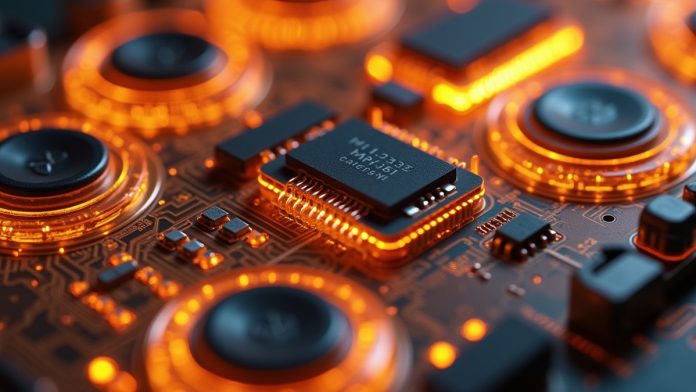In the evolving realm of digital cinematography, the integration of cutting-edge capacitor technology plays a critical role in enhancing imaging performance. Recent breakthroughs titled Advances in Capacitor Design for Digital Cinematography have revolutionized power management, signal clarity, and operational speed in cinema equipment. This new approach fosters overall system efficiency while boosting image fidelity, enabling filmmakers to capture moments with exceptional precision and reliability in both studio and field settings.
| Table of Contents | |
|---|---|
| I. | Advanced High-K Dielectrics for Capacitor Performance |
| II. | Nano-Engineered Capacitor Structures |
| III. | Thermal Stability and Reliability in Capacitor Design |
| IV. | Integration with High-Resolution Image Sensors |
| V. | Low-Noise and High-Speed Capacitor Architectures |
| VI. | Miniaturization and Capacitive Coupling Challenges |
| VII. | Innovative Fabrication and Lithography Techniques |
| VIII. | Energy Management and Power Efficiency in Capacitor Systems |
| IX. | Electromagnetic Modeling and High-Frequency Simulation |
| X. | Next-Generation Trends in Capacitor Innovation |
Advanced High-K Dielectrics for Capacitor Performance
High-K dielectrics represent a breakthrough in capacitor design, providing improved capacitance and reduced leakage currents. This innovation in Advances in Capacitor Design for Digital Cinematography has enabled capacitors to sustain robust electrical fields, thus enhancing performance under demanding imaging conditions. Enhanced material properties deliver superior signal-to-noise ratios that are vital in high-resolution sensors, making these dielectrics an essential component in modern digital cinematography systems.
Nano-Engineered Capacitor Structures
Nano-engineering has paved the way for revolutionary capacitor architectures. In Advances in Capacitor Design for Digital Cinematography, nanoscale modifications permit precise control over capacitor geometry, leading to higher density and lower parasitic losses. These advanced structures result in rapid charge-discharge cycles, critical for high-speed digital imaging. The refined scale also enables integration with microelectronic components, ensuring improved overall performance and durability in cutting-edge cinematic applications.
Thermal Stability and Reliability in Capacitor Design
Thermal management is a cornerstone in ensuring long-term reliability in capacitors. With Advances in Capacitor Design for Digital Cinematography, designs now incorporate materials and structures that mitigate thermal degradation. Enhanced heat dissipation features and robust material interfaces ensure stable performance even under extreme operating conditions. This thermal resilience is crucial for maintaining consistent image quality across varying environmental conditions encountered in both on-set and outdoor shooting scenarios.
Integration with High-Resolution Image Sensors
Integrating state-of-the-art capacitor technology with high-resolution image sensors is transforming digital cinematography. By leveraging Advances in Capacitor Design for Digital Cinematography, seamless signal conditioning and improved dynamic range are now achievable. Capacitors designed with refined electrical characteristics help manage data rates and reduce noise interference, directly contributing to the clarity and detail captured by modern sensors. This synergy is essential for producing lifelike images with outstanding precision.
Low-Noise and High-Speed Capacitor Architectures
Low-noise performance combined with high-speed operation is critical for next-generation imaging systems. The latest capacitor architectures presented in Advances in Capacitor Design for Digital Cinematography focus on reducing electronic interference while supporting fast switching speeds. These designs ensure that transient signals are handled with minimal distortion, thereby preserving the integrity of the video capture process. The resulting improvement in signal fidelity underpins the advancements in high-definition cinematography technologies.
Miniaturization and Capacitive Coupling Challenges
Miniaturization in modern electronics has posed considerable challenges, particularly relating to capacitive coupling in densely packed circuits. Advances in Capacitor Design for Digital Cinematography address these issues by optimizing layout and material design to minimize unwanted interactions. Through innovative isolation techniques and careful engineering, designers achieve reduced cross-talk, ensuring that signal integrity remains uncompromised in compact, high-performance imaging systems. This balance is critical as devices shrink without sacrificing performance.
Innovative Fabrication and Lithography Techniques
State-of-the-art fabrication and lithography processes are enabling the production of capacitors with ultra-fine features. Recent Advances in Capacitor Design for Digital Cinematography utilize advanced etching, deposition, and patterning methods to achieve unprecedented precision. These techniques allow for tighter integration of capacitors with other circuit elements, reducing overall device size while bolstering performance parameters. The leap in manufacturing quality ensures that next-generation digital cameras can meet the rigorous demands of cinematic production.
Energy Management and Power Efficiency in Capacitor Systems
Efficient energy management is vital for modern cinematography, where power consumption and battery life are paramount. Advances in Capacitor Design for Digital Cinematography have led to energy-efficient designs that optimize charge storage and discharge cycles, reducing heat generation and power loss. The improved energy handling capabilities not only extend operational durations but also support the high peak power requirements necessary for rapid image processing. This efficiency is critical for both prolonged filming sessions and field applications.
Electromagnetic Modeling and High-Frequency Simulation
Precise electromagnetic modeling and high-frequency simulation are now integral to capacitor design. Through Advances in Capacitor Design for Digital Cinematography, engineers can simulate and predict capacitor behavior in complex operating environments. These advanced modeling techniques allow for meticulous tuning of electrical parameters, ensuring reliable performance across a spectrum of frequencies encountered in digital imaging. As a result, designers can optimize circuits for maximum performance and minimal electromagnetic interference in modern cinematic equipment.
Next-Generation Trends in Capacitor Innovation
The future of capacitor technology in digital cinematography is bright, with ongoing research leading to even more refined and high-performing components. Emerging materials, hybrid structures, and quantum-scale innovations are at the forefront of Advances in Capacitor Design for Digital Cinematography. These trends promise to further enhance imaging resolution, response times, and energy efficiency. As the cinema industry continues to push technological boundaries, next-generation capacitors will undoubtedly play a central role in the evolution of digital capture systems.

